 Baboon on the beach
Baboon on the beachA recent low tide visit to the beach at Platboom near Cape Point, on the Atlantic coast of the peninsula, enabled us to watch a troop of Chacma baboons (Papio ursinus) foraging for limpets, mussels and other marine snacks on the rocks at low tide. The baboons bite the tops off the limpets with their formidable incisors, or pry them from the rocks intact to get at the protein-rich flesh. They also eat mussels.
 Baboons foraging for seafood at Platboom
Baboons foraging for seafood at PlatboomThis foraging behaviour is extremely rare among primates. In baboons, it is only observed on the Cape Peninsula and in one other species in Somalia. Matthew Lewis studied this troop of baboons as they foraged around the Cape Point nature reserve, and his thesis makes for fascinating reading. (Wild Card Magazine also featured Matthew’s research.)
 Baboon on the beach
Baboon on the beachThe amount of time the baboons are able to spend foraging on the shore is largely determined by the height of the tide, and by weather conditions. As a result, the amount of time the baboons spend seeking marine food sources is small compared with the time they spend looking for roots, bulbs, insects, berries, and small animals.
 Low tide at Platboom
Low tide at PlatboomThese baboons are part of the Kanonkop troop which ranges freely in the Cape of Good Hope section of Table Mountain National Park and whose home range does not bring them into conflict with humans (or, as a rule, allow them access to any anthropogenic food sources). They were completely uninterested in us and our vehicle, unlike the baboons we see further up the peninsula around Millers Point, for example.
 Concentrating baboon
Concentrating baboon






